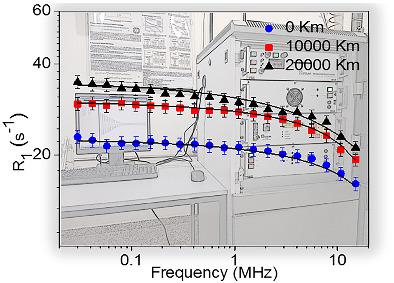当前位置:
X-MOL 学术
›
Magn. Reson. Chem.
›
论文详情
Our official English website, www.x-mol.net, welcomes your feedback! (Note: you will need to create a separate account there.)
NMR relaxometry analysis of molecular degradation in internal combustion engine lubricants
Magnetic Resonance in Chemistry ( IF 2 ) Pub Date : 2020-10-22 , DOI: 10.1002/mrc.5110 Eustaquio M. Erro 1 , Leandro J. Gerbino 1 , Carla C. Fraenza 1 , Esteban Anoardo 1
Magnetic Resonance in Chemistry ( IF 2 ) Pub Date : 2020-10-22 , DOI: 10.1002/mrc.5110 Eustaquio M. Erro 1 , Leandro J. Gerbino 1 , Carla C. Fraenza 1 , Esteban Anoardo 1
Affiliation

|
A set of experimental techniques headed by proton fast field‐cycling nuclear magnetic resonance (1HFFC‐NMR) were used to analyze the effects of degradation of lubricant oil used in an internal combustion engine (ICE). Its relaxometric, spectroscopic, and rheological properties were evaluated and interpreted in terms of changes in the chemical structure and the involved molecular dynamics. In order to better understand the relaxometric behavior, chemical changes induced by heat were investigated for selected n‐alkanes, as model‐systems due to their structural simplicity. Fourier transform infrared (FTIR) spectroscopy, viscosity measurements, and foaming were used to contrast NMR relaxometry experiments. Main observed changes associated with oil degradation can be attributed to molecular oxidation, fragmentation, and ramification. As an outstanding feature of this work, we show that the relaxometric analysis can be done without any special treatment of the sample, allowing results in less than 10 min.
中文翻译:

核磁共振弛豫分析法分析内燃机润滑油中的分子降解
一组以质子快速场循环核磁共振(1 HFFC-NMR)为首的实验技术被用于分析内燃机(ICE)中使用的润滑油降解的影响。根据化学结构的变化和所涉及的分子动力学,评估并解释了其弛豫,光谱和流变特性。为了更好地理解弛豫行为,对选定的n研究了由热引起的化学变化。烷烃,因为其结构简单,因此作为模型系统。傅里叶变换红外(FTIR)光谱,粘度测量和发泡用于对比NMR弛豫实验。观察到的与油降解相关的主要变化可归因于分子氧化,断裂和分枝。作为这项工作的突出特点,我们证明了无需对样品进行任何特殊处理就可以进行弛豫分析,结果只需不到10分钟即可完成。
更新日期:2020-10-22
中文翻译:

核磁共振弛豫分析法分析内燃机润滑油中的分子降解
一组以质子快速场循环核磁共振(1 HFFC-NMR)为首的实验技术被用于分析内燃机(ICE)中使用的润滑油降解的影响。根据化学结构的变化和所涉及的分子动力学,评估并解释了其弛豫,光谱和流变特性。为了更好地理解弛豫行为,对选定的n研究了由热引起的化学变化。烷烃,因为其结构简单,因此作为模型系统。傅里叶变换红外(FTIR)光谱,粘度测量和发泡用于对比NMR弛豫实验。观察到的与油降解相关的主要变化可归因于分子氧化,断裂和分枝。作为这项工作的突出特点,我们证明了无需对样品进行任何特殊处理就可以进行弛豫分析,结果只需不到10分钟即可完成。



























 京公网安备 11010802027423号
京公网安备 11010802027423号